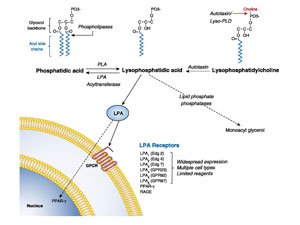
Two main sources of LPA generation
are from phosphatidic acid (left)
via the action of phospholipases
or by hydrolysis of the choline moiety
of lysophosphatidylcholine (Lyso-PC), by
ATX (also known as Lyso-PLD).
(Enlarged image)
Lysophosphatidic acid (LPA) is a pleiotropic lipid molecule with potent effects on cell growth and motility. Major progress has been made in recent years in deciphering the mechanisms of LPA generation and how it acts on target cells. Most research to-date has been conducted in other disciplines, but emerging data indicate that LPA has an important role to play in immunity. A key discovery was that autotaxin (ATX), an enzyme previously implicated in cancer cell motility, generates extracellular LPA from the precursor lysophosphatidylcholine (LPC). Steady-state ATX is expressed by only a few tissues including high-endothelial venules in lymph nodes, but inflammatory signals can up-regulate ATX expression in different tissues.
We study the role of the LPA/ATX axis in lymphocyte migration and in mouse models of allergic airway inflammation. Current projects in the lab make use of new gene-targeted mouse models and pharmacologic antagonists testing the hypothesis that epithelial-derived ATX contributes to leukocyte recruitment and inflammation. We are also exploring the therapeutic potential of a novel LPA2 agonist. In separate clinical projects, we are studying whether LPA and ATX are useful biomarkers of asthma or pollution exposure in different cohorts.
Further Reading
The autotaxin-LPA axis emerges as a novel regulator of lymphocyte homing and inflammation.. Knowlden S, Georas SN. J Immunol. 2014 Feb 1;192(3):851-7.